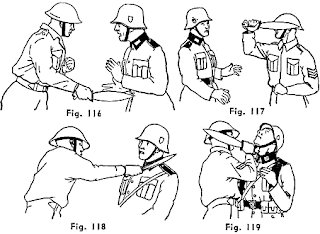Today marks the last day of October and if you have been following along with me, that means it's also the last day of Inktober where artists draw a picture a day in October. I am not suggesting I'm an artist though. I used Inktober to practice my 'gesture drawing' skills as well as read/reread/research knifefighting. Why knifefighting? Learn how to use the knife in order to know how to defend against it.
Can you believe it? It seemed daunting at the onset, but lo and behold, here we are! For my Day #31 of Inktober picture, I'm focusing on Craig Douglas' Pikal expression.
Thank you all for your feedback and support as well as joining me in this project in my Sojourn of Septillion Steps!
In case you missed my other Inktober pictures on stance I've posted, please check out:
- Inktober Day #2 - DBMA's Chupacabra knifefighting stance
- Inktober Day #4 - Bob Kasper's/Kni-com's knifefighting stance
- Inktober Day #7 - Richard Ryan's/DCM's Knifefighting Stance
- Inktober Day #8 - Michael Janich's/MBC's Knifefighting Stance
And in case you missed my other SouthNarc/Craig Douglas entries I've posted, please check out:
- SELF-DEFENSE: Southnarc (aka Craig Douglas) - A "Systems" Approach to Building a Profile
- SELF-DEFENSE: Southnarc (aka Craig Douglas) - Battle Glad and Strife Eager
- SELF-DEFENSE: Southnarc (aka Craig Douglas) - The Myth of Proportional Armament
- SELF-DEFENSE: Southnarc (aka Craig Douglas) - Training Structure & the Criminal Assault Paradigm
- SELF-DEFENSE: Southnarc (aka Craig Douglas) - The Conditioning Corollary and Victim Selection
- SELF-DEFENSE: Southnarc (aka Craig Douglas) - Managing Unknown Contacts
- SELF-DEFENSE: SouthNarc (aka Craig Douglas) - Some thoughts on the "Default Position"
- SELF-DEFENSE: Southnarc (aka Craig Douglas) - Competition and Conversion
OK, now that the above 'housekeeping' is done ...
(Begin Big John McCarthy voice :-)
Are you ready?
LET'S GET IT ON!
(/voice)
From "An Expression of Pikal"
Craig Douglas aka "SouthNarc"
Pages 1-2
Points
- "Pikal" - Visayan dialect; means "to rip"
- "RGEI" - Reverse Grip Edge In... Edge facing body... thrust-heavy application
- Angles are simply the common #1 and #2 strokes in Filipino Martial Arts regardless of whether it's a diagonal, horizontal, upwards or downwards
- Objective: Bull through adversary, thrusting like a sewing machine, rapid-fire and ballistic
- Attributes that drive the system:
- Footwork - allows one to close and hit
- Power - drives blade and sink tip through flesh/clothing
- Mechanics - hook and clear the interrupted thrust line
Stance
- Weapon side forward
- Point facing adversary
- Unencumbered hand behind weapon
- On balls of feet for quick zoning in and out of range
- Keep everything compacted
Notes
- Face obscured because at the time, SouthNarc was still an active duty undercover narcotics officer in the southern USA when he shared his expression of Pikal, hence, his nick of "SouthNarc"
- Rear heel raised
- RGEI - prior to Craig Douglas sharing his expression of Pikal, there were not many instructors publically teaching the RGEI... any time you look in a book or article prior to his teaching, anytime you saw reverse grip aka "icepick" - the edge was facing out and not INTO the body!
- Humans are generally stronger pulling in than pushing out and with RGEI, a lot of damage can be caused on the pull-in
- More on SouthNarc's Pikal in the near future.
My drawings for Inktober 2017 - drawing at least 1 pic each day in October:
- Inktober Day #1 - Taiji's "Snake creeps down"
- Inktober Day #2 - DBMA's Chupacabra knifefighting stance
- Inktober Day #3 - Peacock Pose/Mayurasana/Kujaku
- Inktober Day #4 - Bob Kasper's/Kni-com's knifefighting stance
- Inktober Day #5 - Bob Kasper's/Kni-Com's "Passata Sotto"
- Inktober Day #6 - "Grab & Stab" vs. "C" Grips
- Inktober Day #7 - Richard Ryan's/DCM's Knifefighting Stance
- Inktober Day #8 - Michael Janich's/MBC's Knifefighting Stance
- Inktober Day #9 - Michael Janich's/MBC's "The Filipino Grip"
- Inktober Day #10 - Bob Kasper's/Kni-com's In-Waist Band Carry
- Inktober Day #11- Trapping's "Pak Sao"
- Inktober Day #12 - Bob Kasper's 'palm push'
- Inktober Day #13 - Bob Kasper's tiger claw entry
- Inktober Day #14 - Michael Janich's Vascular Knife Targets
- Inktober Day #15 - John Styers' On-Guard Stance
- Inktober Day #16- "Box Theory" by Terry Trahan
- Inktober Day #17 - Bob Kasper's 5th Principle of Knifefighting - "Stay in the box."
- Inktober Day #18 - Dwight McLemore's/American Fighting Congress' "Window of Combat"
- Inktober Day #19 - Beware the hidden knife!
- Inktober Day #20 - Richard Ryan's Tactical Concealment/Deceptive Carry Methods
- Inktober Day #21 - Lee Morrison's/Urban Combatives' Body Language Cues
- Inktober Day #22 - Lee Morrison's/UC's The 3 Es
- Inktober Day #23 - John Styers' In-Quartata (or Out-of-Line)
- Inktober Day #24 - John Styers' Passato Sotto
- Inktober Day #25 - John Styers' Targets
- Inktober Day #26 - Amante Marinas'/Pananandata's 12 Targets
- Inktober Day #27 - Fernan Vargas'/Raven Combatives' Fairbairn Vital Template
- Inktober Day #28 - Bloody Brazilian Knife Fighting Techniques' Immobilizing Targets
- Inktober Day# 29 - Hank Reinhardt - Old fencing trick
- Inktober Day #30 - Michael Janich's/MBC's Abanico

























